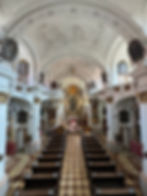Stift Dürnsteig - a Fancy Museum in a Pearl of a Village
- Mika Vepsalainen
- Aug 17, 2024
- 2 min read
Join us for a visit to a village that is taken out of a medieval novel, clinging to a strip on the north bank of the Danube in Wachau in Lower Austria. The name comes from a castle on the cliffs above. There is not much left of the castle, though.

The real sight today is the former Dürnstein monastery where the blue and white tower of the abbey is the real landmark of the whole of Wachau. The abbey church is dedicated to the Assumption of Mary into Heaven with the feast day 15 August.
In 1372 a chapel was founded on an estate that the widow Elisabeth von Keening had bequeathed. It was dedicated to Mary, mother of God, St Andrew, St Laurence and all saints. Interestingly, the Dürnstein Abbey was only founded fourty years later in 1410.
A certain Hieronymus Übelbacher was elected provost in 1710. As the monastery was in a deplorable condition, he gave it a fresh look with a baroque makeover that also matched with the time’s atmosphere of religion, science and culture. The most striking new individual feature was the blue and white tower of the collegiate church, which was restored to its original colour scheme. It is covered with precious reliefs of the suffering of Christ. Four obelisks on the tower bear the images of the apostles.
The organ was originally built in 1719 and installed in the vestry. In 1723 it was transferred to the new music choir and then rebuilt and expanded by the Viennese organ builder Johann Christoph Pantzner. It is his only work that has survived and is still in its original condition today.
When the monastery was dissolved in 1788 under Emperor Joseph II, Dürnstein Abbey with its parishes and associated buildings became part of the Augustinian Canons' Abbey of Herzogenburg, to which it still belongs today. The large property fell to the Starhemberg princely family, who still manage the property today and the vineyards were sold to the Dürnstein winegrowers' cooperative in 1938.
The baroque jewel of a museum saw a new start in 2019 with a new museum established with the State of Lower Austria and the Friends’ Association with a new permanent exhibition “Discovery of the Precious”.
The Abbey is open daily from April till October and you can also arrive by boat.
The museum shop has a fine selection of devotional items should you be interested in the spiritual more than the history. There is no museum café as such but plenty of options in the vicinity.
The museum is fully accessible and there is a loo for the handicapped.
Stift Dürnstein
Nr. 1, 3601 Dürnstein












